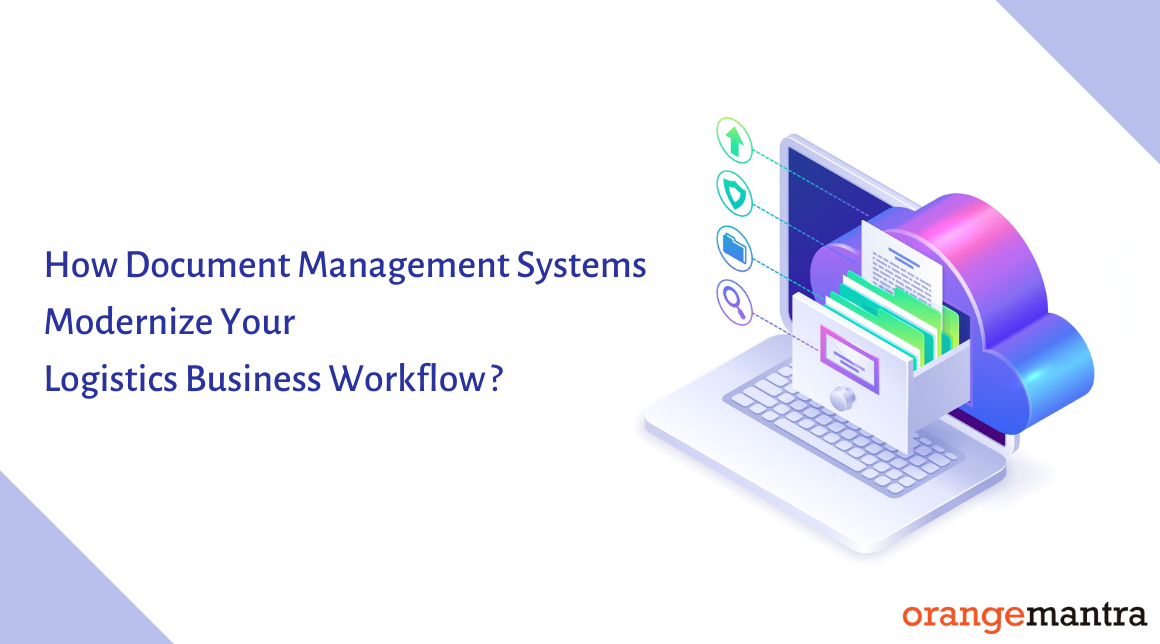If you are into logistics, you have to deal with an endless amount of paperwork.
Most people working in the transportation and logistics business have to shuffle papers daily. You must be having several documents stored in cabinets, the room filled with important papers or maybe having electronic bills stored inside the phone.
When you need to find that one particular invoice, a contract, a bill, or something like that, you simply utter, “Where is that document”?
Most of you must have come across the same situation as that. It takes a massive toll on your time, productivity, and workflow management.
So, this is where you need to implement an end-to-end Document Management System for your organization.
This blog is for professionals associated with transportation and logistics management. After reading this, you’ll have better insights about quick decision making and a seamless document management process.
What is a Document Management System?
Document Management System is a tech-enabled software for logistic firms to manage and track e-documents. The feature-rich software helps your organization securely store, track, and manage electronic documents, paper-based information electronically, and scanned docs.
DMS allows logistic companies to seamlessly manage all the paperwork instead of following the old-school ways of filling cabinets with tons of papers. Moreover, the system brings optimum flexibility to transportation and other verticals to access important e-documents anywhere and at any point in time.
Why Document Management Systems?
For decades, several enterprises have faced the challenge of organizing a sheer volume of documents. It can be either stored as electronic files, databases or could be on paper.
To deal with the situation, several companies started maintaining relevant documents in physical appearances & electronic format. But this coexistence led to massive duplication issues that let companies spend more time managing, handling, and filtering the documents.
Using an enterprise-grade Document Management System, you could effortlessly store, secure, and streamline order, supply chain, logistics, bills, and other docs.
How a DMS Reduces the Clutter & Optimizes Logistics Operations
Let’s review how a feature-rich and structured Document Management System can bring transparency and workflow optimization.
-
Immediate Access to Files & Retrieval
Stay away from your unorganized filing cabinets and switch to fully-integrated DMS software to better access documents. By using a simple keyword search feature of the software, swiftly find any document. Be it like driver records, invoices, bills, or any other electronic paper to manage the operations faster and more efficiently.
-
Extraction of High-Volume Data
DMS software efficiently mines the data of your logistic firm. You can quickly extract customers details, vendor information, or data related to the drivers from the system itself. With this in place, there is no need to shuffle across a pool of physical papers.
Find the accurate information instantly on the enterprise device itself for evaluation or any other purpose.
-
Document Security
Undoubtedly, physical records can get damaged or compromised easily. Paper-based materials have a short shelf life if not cared for properly. However, to maintain its relevance, you need extra security measures.
With a self-hosted or a Cloud-based document management system, find no such hassle of obliging hefty security measures. The system itself is secured enough to protect the electronic files. As an enterprise, you can restrict employees from accessing specific files based on the nature of their work.
-
Drivers on Time
The logistic and transportation business runs effectively on speed and time. Any delay in reaching the supplies lead to serious consequences on the reputation of the company.
By implementing DMS, you can provide digital and instant access to information to drivers. It helps them to change or add routes effectively without wasting much time. Moreover, send real-time SMS and email notifications to drivers to request a particular service.
-
Integrating with Existing Systems
The document management system efficiently prevents the creation of duplicate copies of logistic documents and manual data entry. It can integrate with the existing system of business-like CRM, accounting software, etc.
The successful integration of DMS with other enterprise’s systems lead to the transparency of data and security to make product decisions across departments.
-
Reducing Office Expenses
Implementing a DMS system can help logistic companies save a considerable number of expenditures. With this system, you need not spend much on printing, mailing, storage, and security. It creates a digital repository for your organization to manage a massive chunk of data electronically.
Key Features of Document Management System for Logistics Companies
Document Repository: An automated system helps maintain structure storage for an extensive pile of logistic enterprise documents. It further allows employees to label storage documents automatically along with scheduling purging sessions.
Compliance Tracking: Creates a functionality to regularly measure and demonstrate adherence to the set compliance standards & terms. It helps to improve regulatory reporting and mitigate the risk factors.
Document Generation: The platform also acts as a document creator and generator to meet enterprise-level requirements. With this, you can transfer data from third-party sources into the localized templates for reference. The platform helps generate, produce, and edit data-driven documents like reports, notes, contracts, proposals, and more.
File Recovery: This particular feature safeguards the crucial documents in case of oversight or data disasters. The system keeps the regular and automatic backup of the enterprise files.
OCR Capabilities: It is better known as Optical Character Recognition (OCR). The feature helps scan paper into an editable and searchable document on the platform. It further results in converting images into Word, PDF, or in any other format you want.
Electronic Signature: It is one of the useful features of DMS that allows you to use a digital signature. It helps to sign off particular tasks including delivery, freight handover, internal approval, and more. In place of scanning documents, easily fill out requirements with a digital signature.
Document Classification: The platforms utilized Machine Learning algorithms to find particular content and document type. This feature categorizes the documents that make extraction simple and hassle-free.
Offline Access: DMS offers offline support as well, especially in the current era of remote working. It allows employees access to the document repository offline as well and download, view, and modify documents accordingly.
Concluding Thoughts
A document management system (DMS) is a result-oriented asset to your logistic enterprise. It helps teams be more collaborative, digitally connected, and agile over extensive storage of documents and seamless accessibility.
Over here, you have come across an overview of DMS for logistic organization, essential features, and what to expect from it. Get in touch with a professional document management system solutions provider to know more about how to implement & get real-time assistance.
At OrangeMantra, we help you build fully integrated and profitable DMS solutions to create a comprehensive document management system.
Frequently Asked Questions
- What is DMS Used for?
A document management system automatically organizes, secure, and digitize company documents. It creates a central digital repository of documents that is simple to access, edit, and organize. Originally, DMS is implemented to get over the traditional and cluttering way of managing paper-based documents like invoices, contracts, proposals, etc.
- How Does Document Management System Work?
DMS performs the well-integrated functions to capture, store, and distribute enterprise related documents digitally. It creates a central repository of the organization’s documents from different sources as follows:
- Scan and digitize files from papers
- Attachments and emails
- Capture documents from external apps like ERP, CRM, etc.
- Save the user-generated content
- What are the Key Benefits of Implementing DMS in Our Organization?
By implementing a document management system in your enterprise, you not only get online & offline access to all the docs digitally. But also experience the following few advantages:
- Increase work productivity
- Improve collaboration & connectivity
- Decrease the security risk
- Sustain security compliance
- Fast & easy way to search & access documents






















